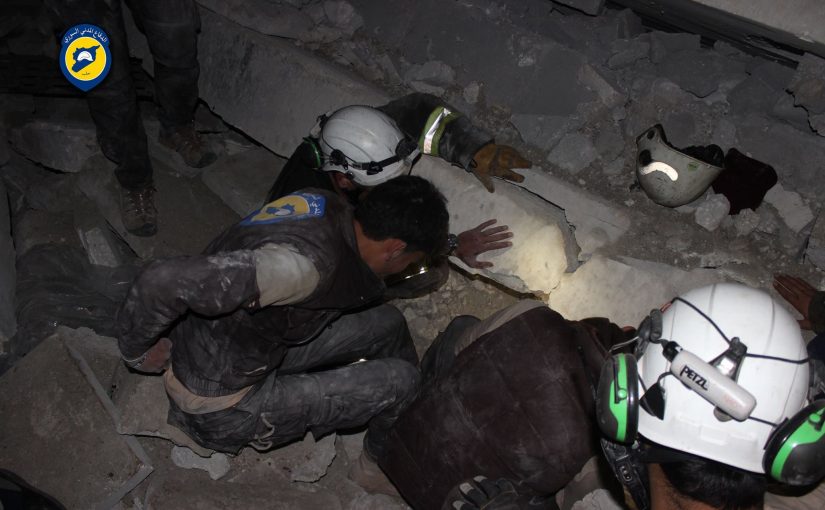The Commission also accused the US of violating international humanitarian law when it bombed a mosque in March.

A Commission of Inquiry for Syria appointed by UN member states has determined that American forces violated international law when they bombed a mosque earlier this year. The Commission said on September 6th that it was also “gravely concerned” about the civilian toll in Raqqa, where Coalition forces have killed hundreds in recent months.
The Commission, which conducted 339 interviews in the course of reporting, highlighted two US and Coalition raids in their findings. One was a unilateral American raid on a mosque in Aleppo governorate which the Commission determined killed 38 people, including a woman and five boys on March 16th. A Coalition strike just a few days later, which hit civilians sheltering in an abandoned school near Raqqa, remains under investigation by the Commission.
The investigatory body also documented more than two dozen instances of chemical weapons use by Syrian regime forces, including an attack in April that left more than 80 civilians dead in Khan Sheikhoun and led to American cruise missile attacks on a government military installation. Russian forces, said the Commission, continued to bomb and target hospitals and medical personnel in Syria.
From the initial hours after the March 16th strike, American officials claimed that al Qaeda members were meeting at the Omar Ibn al-Khatab mosque in al Jinah. In June, US military investigators declared that in spite of numerous errors that led to misidentification of structures in the target area, the strike was lawful. US officials said only one civilian, a “smaller in stature person” – clearly a child – was believed to have died.
Having identified a smaller older mosque nearby, US officials also insisted that the section of the religious complex hit by F-15 jets was not a functional one — an assertion contradicted by numerous local accounts and detailed investigations and analyses carried out by Human Rights Watch, Bellingcat and Forensic Architecture.
Forensic Architecture’s video showing bombed al Jinah building was a functioning mosque.
The Commission was able to confirm the use of GBU-39 munitions – a lower yield bomb which UN investigators said “was used to destroy the target with minimal collateral damage.” However, the Commission said the mosque should not have been targeted in the first place.
Witnesses confirmed to the Commission that members of the al-Qaeda linked group Hay’at Tahrir al-Sham were present in al Jinah. Investigators said they could not rule out “that some members of the group may have attended the gathering.” But, the Commission added, “the United States targeting team lacked an understanding of the actual target, including that it was part of a mosque where worshipers gathered to pray every Thursday.”
“Moreover, although the targeting team had information on the target three days prior, it did not undertake additional verification of target activities in that period, which would be expected were it known to be a mosque,” wrote investigators. The Commission concluded that the US “failed to take all feasible precautions to avoid or minimize incidental loss of civilian life, injury to civilians and damage to civilian objects, in violation of international law.”
The Coalition strike, which took place in al Mansoura village in the early hours of March 21st, is one of the most fraught — and by some accounts deadliest — of the entire air campaign. Initial reports varied greatly but suggested a large civilian death toll. Reports monitored by Airwars named at least dozens of civilian victims.
But a week after the raid, then-coalition commander Lt. Gen. Stephen Townsend called the strike “clean.” Speaking to reporters on March 28, Townsend pronounced “my initial read is: non credible.” His remarks raised concern that the Coalition investigation – not completed for several months – would be influenced by the General’s own conclusion. Ultimately the Coalition determined no civilians had died.
In June, the Commission highlighted the strike at the U.N. Human Rights Council in Geneva, where one Commissioner said the death toll in Mansoura was 200 — however this number may been a reference to reports, and it was not reflected as a conclusive figure in the latest report.
In their new findings, the Commission said they had “credible evidence that the school had been used to house internally displaced people as far back as 2012.”
“At the time of the strike, over 200 people, mostly displaced families from Palmyra, Homs, but also from Hamah and Aleppo, were living in the former school,” reported the Commission. “Some of the victims were recent arrivals, including from Maskanah, Aleppo, while other internally displaced persons had been living there for years.”
The strike, the Coalition found, occurred at night when most were sleeping.
In a June 17th email, Coalition spokesperson Col. Joseph Scrocca said “It is our assessment that no civilians were killed in a strike on a known ISIS torture site, weapons storage facility and meeting place formerly used as a school in Mansoura, Syria, 20-21 March.” Asked then about the disparity between the Commission’s findings, Scrocca asked “are there any photos or videos of the hundreds of civilian dead?”
The Commission interviewed witnesses after both strikes, as did Human Rights Watch. American and Coalition investigators did not speak to locals.